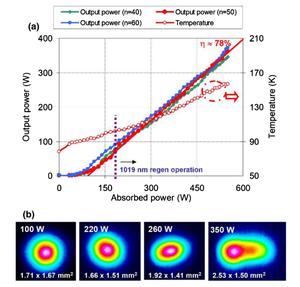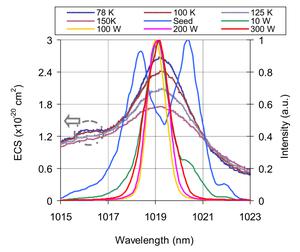Highly Efficient cryogenic Yb:YLF Laser at 250 W
11 December, 2021
Paper among Top-10 Downloads and Editors Pick in Optics Letters
(a) Measured output power of the Yb:YLF regenerative amplifier as a function of absorbed pump power at a 50 kHz repetition rate. The data are taken for different cavity round trips (n) of 40, 50, and 60, using seed energy of 30 nJ. The measured average temperature of the crystal is also shown. (b) Sample near-field beam profiles of the Yb:YLF regenerative amplifier at different output power levels showing the increased role of thermal lensing on the beam profile. (Credit: authors, partly from original publication, licensed under CC BY4.0).
The paper published by the UFOX Laser team in Optics Letters titled: "Highly efficient cryogenic Yb:YLF regenerative amplifier with 250 W average power" became one of the Top-10 Downloads in the Journal in November and even became one of the Editors Picks. In the paper the authors report on a chirped-pulse amplifier system based on cryogenically-cooled Yb:YLF gain media employing the c-axis of the lasing crystal. In Yb:YLF amplifier studies, usually the a-axis with a transition centered around 1017.5 nm is used, because of its broader gain-bandwidth although at cost of lower gain. With the c-axis 1019 nm transition, the emission cross-section is three times higher and as demonstrated still possesses a full-width at half-maximum (FWHM) of 6.5 nm at cryogenic temperatures of 125 K.
The authors demonstrated a chirped-pulse amplifier system which is seeded by a fiber front-end with a seed energy of 30 nJ and a stretched pulse width of 2 ns. The higher gain of the c-axis allows for up to 370 W with an extraction efficiency of 78% at a 50 kHz repetition rate. The output pulses were centered on 1019.15 nm with a FWHM bandwidth of 1.25 nm, which supports sub-1.5 ps pulse durations, crucial for e.g. application in THz generation (AXSIS-Project). The system enables extraction of pulse energies up to 20 mJ with 3% rms noise at lower repetition rates. For output power levels up to 250 W the amplifier output mode was maintaining a M2 of 1.2.
Optical spectrum of seed pulse and regenerative amplifier output pulse at average output power levels of 10, 100, 200, and 300 W. The data are taken at a pulse repetition rate of 50 kHz, using 30 nJ seed energy and with 50 round trips (n D50). The measured ECS for the E//c axis of Yb:YLF is also shown for crystal temperatures of 78, 100, 125, and 150 K. (Credit: authors, from original publication, licensed under CC BY4.0).
Above these power levels, the thermally induced lensing in Yb:YLF created a multimode output beam. In future work, usage of longer Yb:YLF crystals with lower doping could reduce the thermal lensing issue, and enable further power scaling. Moreover, usage of seeder pulse shaping and/or intracavity filtering of the spectra has the potential to reduce the amplified pulsewidths below 500-fs level.
We congratulate the Laser Team for this great result and the success of their paper!
Reference
Highly efficient cryogenic Yb:YLF regenerative amplifier with 250 W average power; Umit Demirbas, Martin Kellert, Jelto Thesinga, Yi Hua, Simon Reuter, Mikhail Pergament and Franz X. Kärtner, Optics Letters (2021)
DOI: 10.1364/OL.430651

